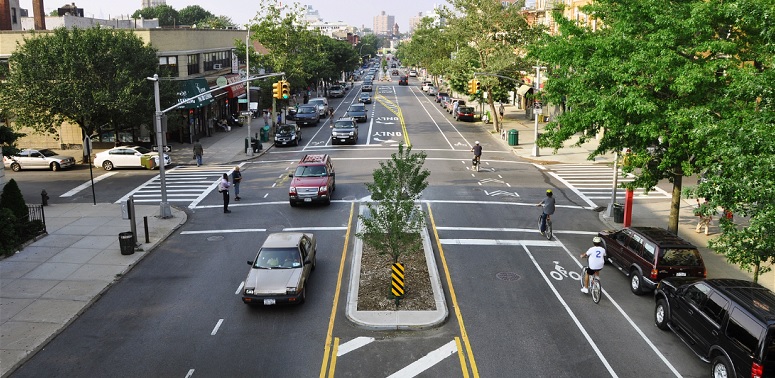MTR reported last month on the announcement that New York will invest $110 million over five years on pedestrian safety. That news is especially welcome given that no state sees more pedestrian fatalities as a share of total traffic deaths than New York.
Some of the $110 million will be invested in infrastructure improvements, like enhanced crosswalks, but the state also intends to spend some of the funds on enforcement and education.
Ideally, our state and local governments shouldn’t have to spend much on enforcement. If a street has a 25 mph speed limit, but it’s been engineered in such a way that drivers feel comfortable going as fast as 40 mph, then the local government needs to spend limited resources on trying to get drivers to slow down.
The need for #slowthecars http://t.co/pBSJBoC3Oa pic.twitter.com/xkc9PN2Xdh
— Center for Sustainable Living (@SustainableCntr) June 23, 2015
But if a street has a 25 mph speed limit and it’s engineered in such a way that most drivers don’t go much faster than 25 mph, then the local government can take some of what they might have otherwise spent on speed enforcement and invest it someplace else.
Great traffic calming design in St. Paul on Maria between 6th & 7th at Metro State. People naturally drive slow here. pic.twitter.com/zM5FNbn0p7
— Richard Holst (@Rich_Holst) September 29, 2015
The same thing goes for educational campaigns. Resources spent on producing and disseminating leaflets and public service announcements about traffic safety are resources not spent on sidewalks, traffic calming or dedicated bicycle infrastructure. If you design a street that fosters safe behavior, then you don’t need to ask its users to behave safely. And because concrete is more permanent than an educational campaign or a targeted enforcement blitz, you don’t have to do it over and over again. This is especially cogent in college towns and resort communities, where much of the population is transient or part-time.
Perhaps the biggest problem that can arise when a city or state tries to solve an engineering problem through education or enforcement is that education and enforcement are often poorly deployed. Take for example what happened this weekend in Brooklyn, where after a bicyclist was mowed down by a hit-and-run driver, police were out in force ticketing cyclists and handing out brochures on bike safety. The whole situation might have been avoided if Grand Street — a popular bike route between East Williamsburg and the Williamsburg Bridge — had a protected bike lane.


[…] such a bad thing. Tim Kovach looks at how sprawl can worsen the heat island effect in cities. And Mobilizing the Region says New York state could save money on traffic enforcement and education by getting the street […]
Maybe stop using ‘engineer’ and ‘design’ as synonymous regarding streets. It maintains the illusion that having good standards and applying them universally, as if you were a state department of highways, is a guarantee of a well-designed street for people.
Yes… and no. Traffic calming will greatly reduce problems with people with good intentions who accidentally speed. However, only enforcement will reduce problems with reckless drivers. It isn’t possible to engineer a street to solve reckless driving. Witness many city streets throughout the US that have not had major problems with speeding and crashes for decades, but have seen recent rises in reckless and distracted driving. We need both traffic calming AND enforcement.
[…] are many factors–street design, police enforcement, driver education–that will determine whether we see another year of increased traffic deaths. But either way, […]